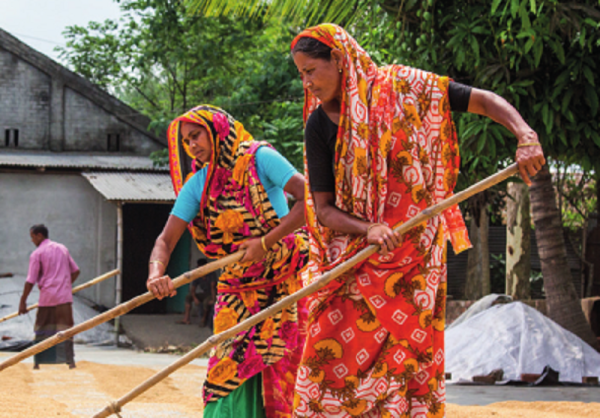
In the wake of the COVID-19 pandemic, South Asian agriculture has a chance to become more inclusive — if certain development paradigms are realized.
Approximately 60 percent of South Asia’s 1.8 billion citizens are involved in agriculture. Bangladesh, India, Afghanistan and other countries depend heavily on the agricultural sector for their economic prosperity. From smallholder farmers to entrepreneurs, women and men across different socioeconomic contexts will need sustainable agriculture instruments to earn steady incomes.
Here are 10 things South Asian agriculture needs to address in the post-pandemic era:
1) Seek gender balance
South Asian economies have swelled considerably, but agriculture has not kept pace. Since both men and women contribute to the agricultural sector, gender relations influence how the agronomy mechanism will work. The United Nations’ sustainable development goal (SDG) 5 finds that gender equality is key to achieving zero hunger as women play an important role in food production. SDG 5 focuses on increasing women’s access to land and natural resources. If female farmers get proper ownership of land and natural resources, they will yield more productivity in food production. Plus, household nutrition will also increase.
2) Take climate change seriously
Climate change is no longer a distant warning that South Asia can ignore. Due to geographical factors, this part of the world is especially susceptible to climate risks. Rising temperatures are adversely impacting crop production, with both short-term crop failure and long-term agricultural diminishment becoming evident. Droughts, floods, sedimentation, soil erosion, mudslides and other extreme weather conditions will continue to challenge farmers. If South Asian nations want to uphold their agricultural legacy, there is only one way out: take climate change seriously.
3) Address the link between high food prices and childhood malnutrition
The International Food Policy Research Institute (IFPRI) predicts crop yields in the South Asian region will see a sizable drop by 2050 due to climate change. Yields of important crops, such as wheat, rice and maize, are expected to shrink by 50 percent, 17 percent and 6 percent, respectively, resulting in higher commodity prices. As food becomes less affordable, children will not get a proper meal, pushing the estimated number of malnourished children in South Asia to 59 million by 2050. This is an intimidating prospect for the future generation.
4) End malnutrition and hunger among women and children
South Asia’s Global Hunger Index (GHI) score for 2019 was 29.3, the highest in the world. The region’s GHI point is heavily influenced by child wasting and stunting rates that, at 17.5 percent and 37.6 percent, respectively, are also the highest in the world. Poor nutrition among women before and after pregnancy, inadequate sanitation facilities and malnourished children are key factors behind this.

5) Restore socioeconomic capacities curbed by COVID-19
Covid-19 has spurred a socioeconomic downturn that will have lasting impacts. Due to the pandemic, an additional 3.9 million children under five will suffer a severe form of malnutrition known as wasting. Though essential nutrition services may have resumed to some extent, the long-term effects of wasting will hinder the economy from reaching its full potential, likely leaving agriculture in a worse shape than it was pre-pandemic. Agricultural activities were hindered during the shutdown period. It is important that farmers get the COVID-19 vaccines early in the rollout so that they can resume their work in the fields. The sooner they get vaccinated, the easier it will be for the economy to rebound.
6) Invest in evidence-based innovations
It is becoming harder to feed the ever-increasing population in South Asia and achieving food security is still a challenge in many countries. The agriculture sector in Bangladesh needs to be realized as a high-value sector. To boost growth in agriculture, policymakers should collaborate with development stakeholders to spearhead evidence-based innovations among smallholder farmers. Investments in mechanized farming, irrigation facilities and high-yielding crop varieties can help the agriculture sector yield promising results. It is also closely related with human capital development.
7) Trade policies and regulations need to be more reality driven
Agricultural development should not just look good on paper, it must be practical. In this part of the world, it is evident that agriculture policy making is plagued with red tape. Policies must be reality-driven and responsive to ensure food security.
8) Adopt biotechnology to improve food security
Biotechnology-driven development can bring a much-needed revolution in farming, allowing us to achieve high yield, improved nutrition and less use of harmful chemicals. Take insect-resistant Bt brinjal for example. Bangladeshi farmers have adopted this publicly developed GM crop and the benefits are already visible. Yields increased by 20 percent and pesticide costs were curbed by 61 percent for the farmers who grew Bt brinjal.
9) Stabilize food prices
COVID-19 has put pressure on commodity prices, followed by farming revenues. But that alone cannot account for the downward trending food index, which began to plummet before the pandemic was in motion. Actions must be taken to stabilize prices so farmers are ensured of a profit and consumers are confident they can afford food.
10) Boost productivity through farm mechanization
Widespread mechanization could change the labor paradigm in agriculture. Machines play a critical role in intensifying land and labor productivity. Women perform a large portion of labor-based work in South Asian agriculture. Mechanization would benefit women by reducing drudgery and freeing up time that they could invest in more productive pursuits. Mechanization also helps boost production and profits, allowing male and female farmers to increase their income.


